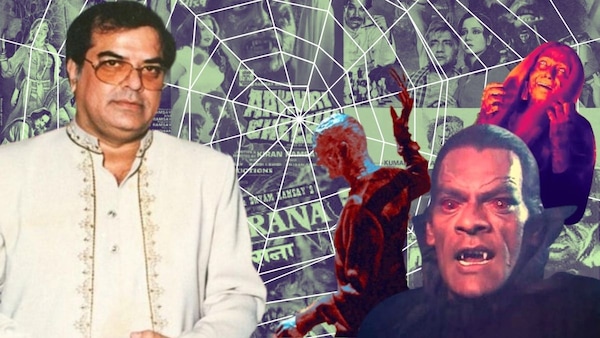Monster Maverick: Gangu Ramsay & Rise Of Indian Horror Cinema
Gangu Ramsay created an eerie atmosphere through lighting, getting just the right frames and close-ups. He did all of this himself with one camera. And that made the Ramsay horror flicks click.

Last Updated: 12.33 PM, Apr 20, 2024
THE beginnings of the Ramsay movie empire can be traced not to a horror flick, but a rousing, patriotic film. The first Ramsay production was Shaheed-E-Azam Bhagat Singh (1954), the very first Bhagat Singh biopic in independent India. Bhagat Singh was portrayed by Prem Adib, famous for playing Ram in several films, and Chandrashekhar Azad was played by Paidi Jairaj. The film, despite having great music, decent casting and a popular subject matter, didn’t do well enough to make Fatehchand Uttamchand, the Ramsay patriarch, try film production again for about thirteen years.
In 1963, FU Ramsay roped in his son Kumar as writer and the great Vishram Bedekar as director, to mount Rustam Sohrab (1967). The film had a stellar cast, including Prithviraj Kapoor, Prem Nath, Suraiya and Mumtaz. The film didn’t break any records but made enough money for them to go on to their next project. Prithviraj Kapoor was impressed enough to work with them again. Vishram Bedekar returned to the director’s chair, and Ek Nannhi Munni Ladki Thi (1970) was made. This was a big film, and they had a lot riding on it. But even this film came a cropper, and the Ramsays faced a setback.

Tulsi and Shyam Ramsay watched the film in a theatre to gauge the pulse of the audience, hoping to detect where they went wrong. They ended up discovering something else altogether. They realised it was just one scene from the film to which the audience responded with enthusiasm. They didn’t care much about the rest of the film. A lot of people came to watch that one scene and then left the theatre. In this scene, Prithviraj Kapoor wore a mask and his body draped in a grotesque costume. As soon as they saw him, they shrieked. It was then that the truth finally dawned on the Ramsays: the audience loved to be terrified.
Armed with this new knowledge, the "Ramsay Brothers" now planned to make films packed with these kinds of scenes. But Fatehchand was now disillusioned with filmmaking, having lost so much in the process. The brothers somehow convinced their father to give this new genre a shot. He was on board, and they resolved to make this new film at a shoestring budget. And one way to do that was to play to their strengths. They were seven brothers, and each one agreed to contribute in whichever way they could. Legend has it that they locked themselves up in a room and conducted filmmaking workshops of their own. They bought Joseph C Mascelli’s The Five Cs of Cinematography and made it their bible.
The brother who benefited the most from this book was probably Gangu Ramsay. Gangu, second of the seven, was already interested in photography. He was into still photography and it was evident in how he eventually framed his shots. The brothers divided filming responsibilities; Gangu was given the job of manning the camera. The Ramsay brothers struck gold with their very first foray into horror, Do Gaz Zameen Ke Neeche (1972). At a modest budget of Rs 3.5 lakhs, they ended up raking in over 40 lakhs. They churned out film after film in a virtual conveyor belt: Darwaza, Saboot, Guest House, Purana Mandir, Saamri, Veerana, Bandh Darwaza and so on. In each one of them, it was Gangu who was the cinematographer.
It was a huge responsibility since a lot depended on trick photography and building the ambience. Gangu excelled each time. The Ramsays often cast A-list actors, and they agreed because box-office success was virtually guaranteed. All these actors vouched for the genius of Gangu Ramsay. In their heydays, the brothers only had a single Arriflex camera, through which Gangu created sheer magic. Anirudh Agarwal, who shot to fame for playing the evil Saamri, didn’t loom as large as he was portrayed in the films. It was Gangu’s skill that made him look taller than he was. He made him stand on a stool and shot him with a fish eye lens, as the actor moved only his upper body to give the illusion of movement.
In the Ramsay films, not everything was about prosthetics, fake limbs or severed heads. Much of it was about creating the aura and making the audience feel the chill in their bones. Gangu was able to create this eerie atmosphere through lighting, getting just the right frames and close-ups. He did all of this himself with one camera! In the later years, Gangu Ramsay was a major creative force behind the cult TV shows namely Zee Horror Show, X Zone and Anhonee, among others.
Gangu rarely sought work outside the Ramsay bandwagon, but he did work as a cinematographer in Umesh Mehra’s Aashik Aawara (1993), Saif Ali Khan’s debut vehicle. A camera trickster, known for showcasing monsters, was hired to make a new hero and a heroine look like a million bucks. Saif Ali Khan won the award for Best Male Debut that year, and Mamta Kulkarni, the heroine, was awarded “Lux New Face of the Year” at Filmfare. And therein lies the genius of Gangu Ramsay.
Amborish Roychoudhury is the National Award-winning author of 'In a Cult of Their Own: Bollywood Beyond Box Office'. His latest book 'Sridevi: The South Years' was released on August 5, 2023.
